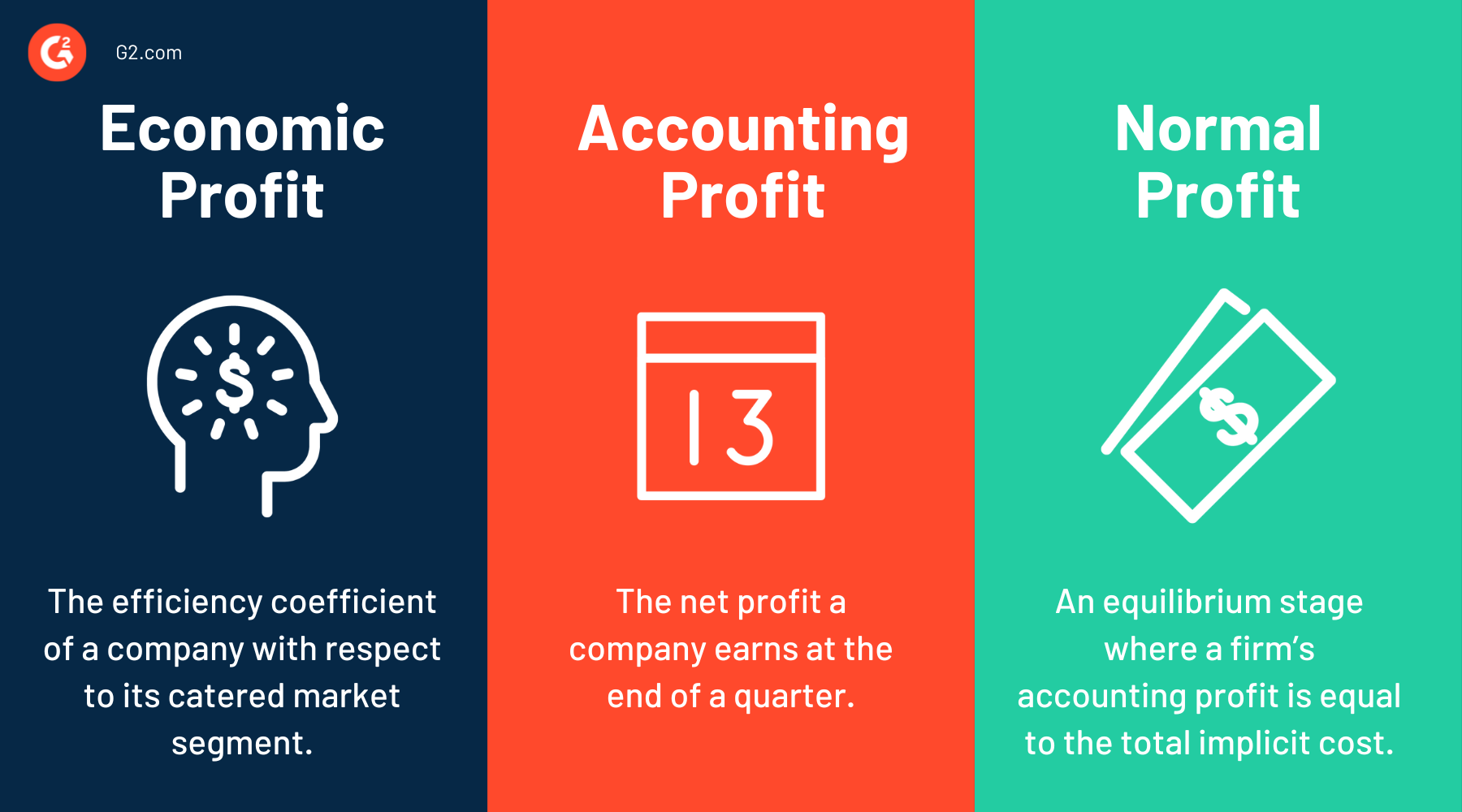What is economic profit?
Economic profit is the difference between a company’s gross revenue and total expenditure, including explicit and implicit costs. Explicit costs are normal business costs mentioned on a company’s balance sheet like the cost of inventory and employee wages. Implicit costs are the cost of resources that could have been better used like opportunity costs, time, etc. Opportunity cost is the cash foregone by a company by choosing an existing business strategy over other alternatives.
Economic profit is an economist’s favorite way to assess the current market position and business strategy of a company to estimate revenue growth. It compares a company’s net income with income that could have been generated in the past using alternative options.
Economic profit predicts whether a company should enter or exit a market. It derives the serviceability of the current business model to gain a monopoly. To predict the exact economic profit, companies use accounting software that automates, and streamlines financial transactions across customer teams.
Economic profit is often confused with accounting profit, which is the net profit a company earns in a quarter or over an accounting cycle.
Benefits of economic profit
Economic profit is a critical component for owners, investors, shareholders, and stakeholders with regard to making an informed decision about a specific business model or the stock market. Though the process is time-consuming, it’s worth the effort. Brands only succeed when they analyze all the risks associated with their product niche and decide on the best approach for long-time market survival.
Analyzing economic profit helps companies :
- Explore a multitude of avenues to expand their product footprint.
- Gain optimum market knowledge about existing competitors.
- Invest in short-term business alternatives to facilitate working capital.
- Ensure confidentiality of financial information among senior-level management.
- Optimize the marketing budget for smart allocation of resources.
By investing in powerful budgeting and forecasting software, companies can ensure established revenue goals and a firm trajectory for their business plan. The more up-to-date forecast is, the better company can optimize resources to maximize ROI.
Economic profit formula
A firm can have a large accounting profit but no economic profit. The calculation of economic profit may vary depending on the brand equity of a company, competition level, incumbency, and market risks. However, economists rely on one standard approach to evaluate the economic stability of an entity.
Suppose, XYZ baking company pulled in gross revenue of $60,000 this quarter. Out of the gross revenue, it’s required to pay the cost of goods, which is $10,000 and for explicit expenses, which is $40,000.
Had the company invested in an additional patisserie business, it would have made an additional income of $30,000. Hence, $30,000 would be the “forfeited amount” or “opportunity cost” that was foregone by the company due to a lack of investment capital.
Note that “cost of goods” has been taken as a separate metric in this example. Normally, it’s a part of “explicit cost”.
To calculate the economic profit of XYZ baking company, let’s list out all the statements first:
| Gross revenue | $60,000 |
| Cost of goods | $10,000 |
| Gross profit | $50,000 |
| Explicit costs | $40,000 |
| Opportunity cost | $30,000 |
Economic profit = Gross revenue - (Cost of Goods- Explicit Costs + Opportunity Cost)
$50,000 - ($40,000 + $30,000) = - $20,000
The company actually suffered an economic loss of $20,000. If the explicit cost would have been decreased by 20% of the current amount, the economic profit of the company would have improved.
Economic profit example
Maria left her full-time job as a lawyer to run a restaurant business. She rented a space in the middle of the city for $2000 per month and started a burger joint with an initial investment of $30,000. In the first year alone, she made a net income of $150,000. However, to earn this money she had to quit the old job that paid her $200000 a year.
Her accounting profit as of now is $150,000-$30,000-$2000 = $118,000. But in the same year, she could have earned an income of $200,000. So, her economic profit comes out to be:
Economic profit = accounting profit - opportunity cost
Economic profit = $118,000 - $200,000 = - $82,000
This means that Maria suffered a negative economic profit or economic loss of $82,000.
Despite the loss, she continues to run her restaurant business and cook burgers. The scenario changed in the second year of her service when word got out about her amazing burgers. She makes a striking profit of $1,000,000, which is roughly five times the salary she drew as a lawyer.
As the explicit costs remain constant, a positive economic profit of $568,000 is obtained even after deducting the $400,000 salary of two years she would have made as a lawyer.
The components of economic profit
Economic profit gives a potential investor or shareholder insight into a company’s current operational efficiency. Although it’s not explicitly disclosed in the company’s income statement, it’s wise to measure an organization’s long-term success.
To calculate economic profit, it’s imperative to analyze the trade-off incentive between two successive business methods and determine which one would be better than the other one.
Here are some important components that help estimate economic profit:
- Accounting profit, also referred to as financial profit, is the net profit mentioned in a company’s income statement. Accounting profit is obtained after subtracting the company’s total expenditure, accumulated depreciation, explicit costs, taxes, and all other procurements from revenue. It shows a firm’s potential to sustain its business in the market. Accounting profit is stipulated under generally accepted accounting principles (GAAP).
- Revenue is generally referred to as the gross revenue or top line. It’s a summation of accounts receivable and additional sales that are mentioned at the top of the income statement. It reflects a company’s ability to sell its services along with its growth potential. A company that increases its revenue every quarter is known to have top-line growth. It’s also an indicator of a high number of the company’s current assets.
- Explicit costs are the total cost of a company that’s due in a standard business timeframe. It refers to direct or indirect payables a company owes to one or more creditors. Examples include inventory costs, employee wages, infrastructure costs, income tax, bonds, or bills. A company is said to be generating profit only if the value of explicit costs is strictly less than total revenue.
- Implicit costs are non-quantifiable costs that a company incurs but doesn’t attribute to its income statement. It represents opportunity costs that arise as a result of in-house utilization of resources toward a specific task without any compensation. Implicit costs are a measure of time, utility, labor, and energy spent on a particular activity that’s not cashable. Trading off a company’s real resources and assets for economic gains is a correct way to measure economic profit accurately.
- Opportunity cost is the amount of money that a company relinquishes by choosing an existing business venture over other alternatives. This metric lets a company assess all possible streams of generating revenue before deciding on the final approach. It doesn’t necessarily involve money and can be either implicit or explicit in nature. Estimation of opportunity costs in retrospect can lead to higher returns on investment and efficient allocation of budget.
- Bottom line refers to the net income, profit, or earnings per share that a company owner shows openly and reserves for themselves after paying all their accrued expenses. The term “bottom line” refers to the relative location of net income in the income statement. Depending on market conditions, the bottom line of an income statement can be adjusted by business decision-makers by honing current business strategies and increasing revenue avenues.
Economic profit considerations
Economic profit is the most suitable financial metric for a company to build a business strategy around. It provides a correct estimation of whether the company should enter or exit a particular market for business.
Let’s say, a company makes money after the sale of a production batch. This money or revenue can be calculated by multiplying the average cost of produced goods by the number of units manufactured in a batch.
Revenue = (Cost of goods sold/price per unit) X Number of units manufactured
Cost of goods sold (COGS) is the most basic explicit cost and is used to derive per unit production cost. The increase in revenue that results from the sale of one production unit is known as marginal revenue.
Subtracting total explicit costs that include salary, inventory, raw materials, rent, or taxes from this acquired revenue gives us the value of accounting profit.
Accounting Profit = Revenue - Explicit Cost
or
Revenue = Accounting Profit + Explicit Cost
This makes a lot of sense as both accounting profit and explicit costs are direct consequences of revenue.
Further, adding or subtracting the estimated value of opportunity cost gives us the value of the economic profit of the firm for that particular quarter.
Economic Profit = Revenue - Explicit Cost ± Opportunity Costs
Putting in the value of accounting profit in the above equation:
Economic Profit = Accounting Profit ± Opportunity Cost
Opportunity costs need to be added in case the return on the foregone option is less than the return on the chosen option; Conversely, it’s subtracted in case the return is more. The value of opportunity costs can be calculated during cost-benefit analysis.
Role of opportunity costs in economic profit analysis
Opportunity costs also help probe critical business problems related to revenue generation. During the manufacturing process, a company calculates the expected sales of their product against existing sales numbers and figures out the best way to generate higher profit margins. Management also considers opportunity costs to make informed decisions about production levels or working efficiency.
Economic profit vs. accounting profit vs. normal profit
To fully understand economic profit, it's best to understand how it differs from accounting profit and normal profit.

Economic profit is an efficiency coefficient of a company with respect to its catered market segment. This form of profit determines a company’s unrestricted cash flow to sustain permanently in the market. It subtracts the value of opportunity cost to analyze the positives and negatives associated with strategy outcome. Implicit costs, which are not quantifiable and relate to human resources, are also factored in during economic profit analysis.
Accounting profit is the net profit a company earns at the end of a quarter. It’s the difference between total revenue and explicit costs incurred such as sales and marketing, logistics and warehousing costs, raw materials, and employee wages. Also known as actual profit, accounting profit is calculated using GAAP.
Normal profit or zero economic profit is an equilibrium stage where a firm’s accounting profit is equal to the total implicit cost. It means the business holds significant cash deposits to survive in a perfectly competitive environment without exploring additional monetary avenues. However, a state of normal profit also classifies that a company isn’t branching into different profitable subsidiaries for increasing annual production turnover. It’s not the same as a negative economic profit, but it isn’t ideal either.
Typically, a company discloses its accounting profit in a financial statement that is reported to the tax department or internal revenue services (IRS) for nominal valuation.

Shreya Mattoo
Shreya Mattoo is a Content Marketing Specialist at G2. She completed her Bachelor's in Computer Applications and is now pursuing Master's in Strategy and Leadership from Deakin University. She also holds an Advance Diploma in Business Analytics from NSDC. Her expertise lies in developing content around Augmented Reality, Virtual Reality, Artificial intelligence, Machine Learning, Peer Review Code, and Development Software. She wants to spread awareness for self-assist technologies in the tech community. When not working, she is either jamming out to rock music, reading crime fiction, or channeling her inner chef in the kitchen.


